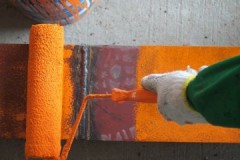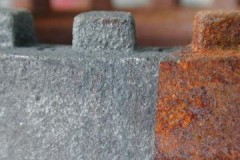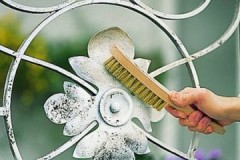Valuable advice on how and how to remove rust from a knife
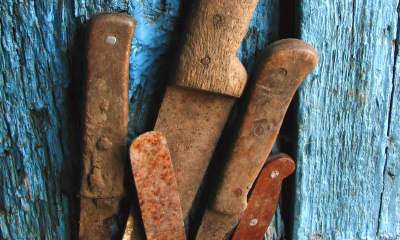 The appearance of rust on the surface of the knife blade or in its folding mechanism is not only an aesthetic defect. The oxide renders the instrument unusable.
The appearance of rust on the surface of the knife blade or in its folding mechanism is not only an aesthetic defect. The oxide renders the instrument unusable.
Therefore, timely removal of rusty deposits and the use of preventive measures are essential elements of knife care. For these purposes, use home methods or ready-made chemical solutions.
Read about how and how to remove rust from a knife at home and restore its original appearance in the article.
Content
How to restore the original appearance of the product with folk remedies?
Iron oxides and hydroxides appearing on the surface of a steel blade can be easily removed using household "reagents". Such products are appreciated for their ease of use and affordable price..
Vinegar and lemon juice
These products contain organic acids (acetic and citric), which actively interact with iron oxides. The resulting salts are easily washed off the metal surface, restoring its purity and shine. Chemical cleaning is considered one of the most effective ways to fight rust.
The instructions for using the lemon-vinegar mixture are simple:
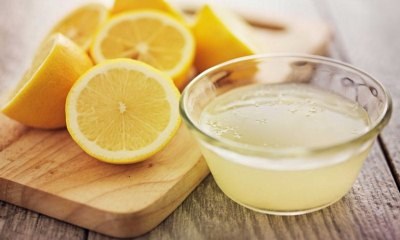 Vinegar (6-9%) is mixed with lemon juice in a volume ratio of 1: 1.
Vinegar (6-9%) is mixed with lemon juice in a volume ratio of 1: 1.- A cloth napkin is liberally moistened in the resulting solution.
- Wrap the knife blade in a liquid-soaked cloth.
- Leave the product for one hour to react.
- Wipe the blade with a sponge, rinse and wipe dry.
It is not recommended to use vinegar essence for home cleaning. The whole procedure with the use of vinegar must be carried out with an open window or under an exhaust hood.
Read about the use of vinegar against rust in this article.
How to get rid of with tomato paste?
Natural product from tomatoes has a mild anti-corrosion effect. The effect is also based on the acidic content of the product.
In the absence of tomato paste, it can be replaced:
- fresh tomatoes,
- tomato juice
- ketchup.
This home remedy compares favorably with peers for its safety and ease of use. However, it only helps to get rid of newly appeared small rust spots. A stronger cleaner is recommended to remove thick deposits.
Coca Cola
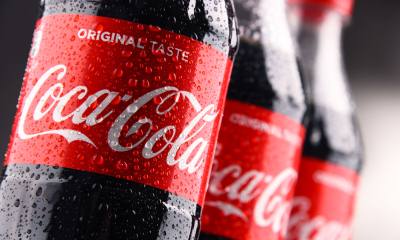 A carbonated drink is a popular cleanser metal surfaces from rust.
A carbonated drink is a popular cleanser metal surfaces from rust.
The orthophosphoric acid contained in the drinking liquid is an active rust converter.
The method using Coca-Cola (Pepsi, Fanta or other similar drinks) is in demand due to its high efficiency and availability.
Coca-Cola is poured into a low container, the product is placed in it and left for 30-40 minutes... After the specified time, check the result by lightly rubbing the blade with a sponge. If there are orange traces on it, the exposure time is extended by another 15-20 minutes.
Read about the use of Coca-Cola against rust in this article.
How to remove plaque with petroleum jelly and lactic acid?
The combination agent helps to clean the blade of rust and at the same time protect it from re-corrosion. Lactic acid acts as a purifier, which neutralizes the oxide by forming it into iron lactate, which is soluble in liquid paraffin.
The method is considered effective, but its use is somewhat limited due to the fact that pure lactic acid is not available in every home. For the preparation of a corrosion inhibitor instead of vaseline paste, you can take wax or paraffin.
Vegetables
This category of cleaners includes potatoes and onions. The juice secreted by tubers and bulbs contains organic matter of an acidic nature. They determine the high efficiency of this method. To facilitate cleansing, use salt, baking soda, or laundry soap as additional ingredients.
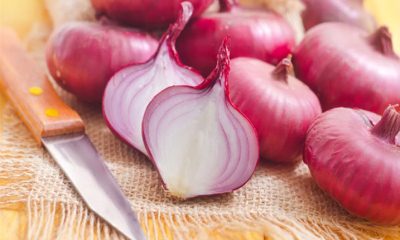 The cleaning procedure is as follows:
The cleaning procedure is as follows:
- Cut the potato or onion in half.
- Sprinkle the cut with salt, baking soda, or shaved soap.
- When juice appears on the cut, the knife is wiped with a vegetable slice.
- Soak the product on the blade for 30-40 minutes.
- Rub the knife with a sponge, removing the remaining traces.
If necessary, during cleaning, the blade is re-moistened with potato or onion juice so that the surface does not dry out.
How to clean with special compounds?
Knife owners who do not trust folk recipes or, for subjective reasons, prefer to use household chemicals, can choose a tool from the store. The range of ready-made rust converters is wide enough. The most popular are time-tested liquids and concentrates.
Adrilan
Russian product positioned as a fruit gel, designed to remove rusty marks from the surface:
- metal utensils,
- tool,
- plumbing.
The gel is evenly applied to the surface of the blade, kept for a short time. Then the brown mass is brushed off the blade with a brush and washed with water. A 0.664 kg bottle is sold for an average of 80 rubles.
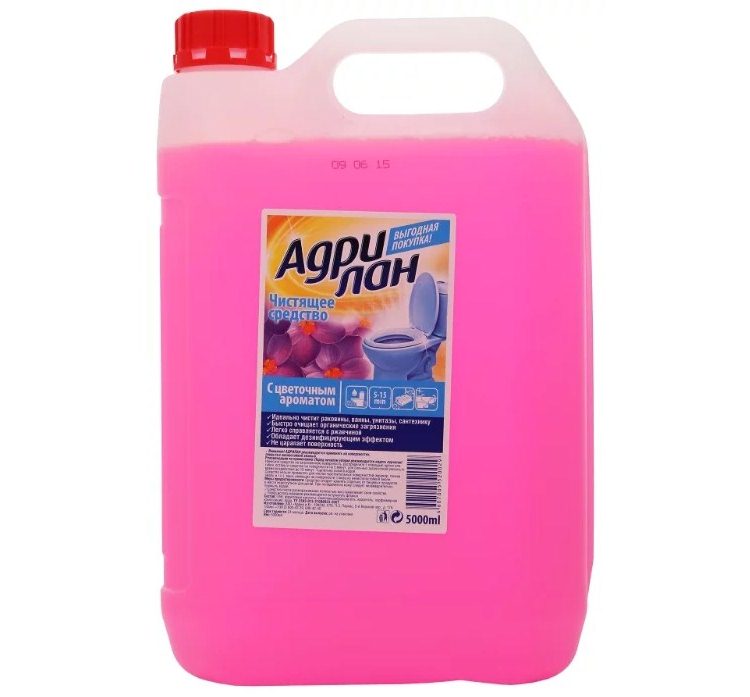
AVS AVK
Liquid product containing active zinc ions, inorganic acids and functional additives in the formula... Zincach is suitable for cleaning steel and cast iron products from a layer of rust up to 80 microns thick. The zinc converter additionally protects the metal from re-corrosion.
Shake the contents of the vial before use. If necessary, remove the loose layer of rust.Further, the agent is evenly applied to the blade. Withstand 30 minutes and apply a second layer. The cost of a small 60 ml bottle is 50 rubles on average.
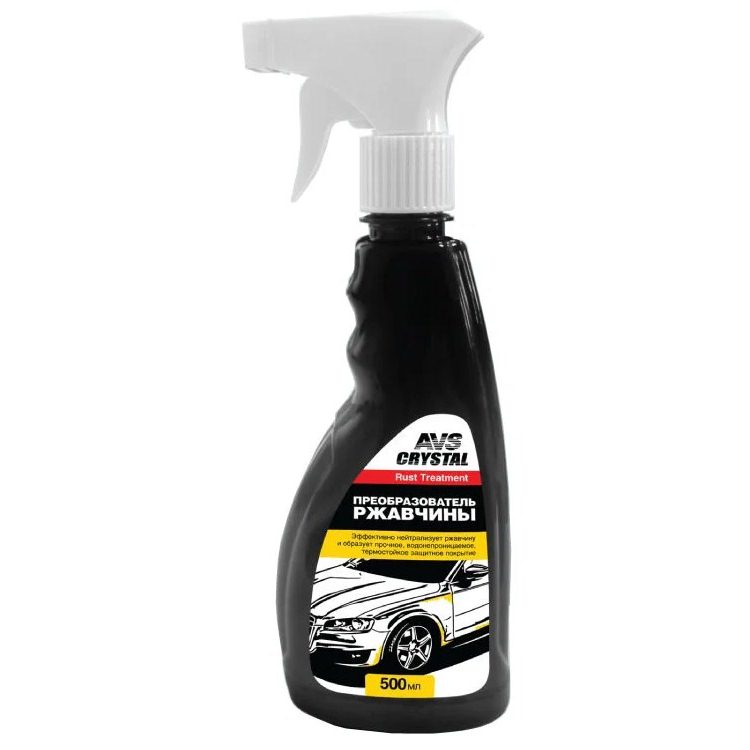
RUNWAY
American-made professional rust remover. Suitable for all metal surfaces, except for electroplating... RUNWAY is used for domestic and industrial purposes.
The agent is applied to the metal surface for several minutes. Remove the formed plaque and dry the surface. A small bottle (30 ml) is sold for 90-110 rubles. A larger bottle (120 ml) is estimated at 220-250 rubles.
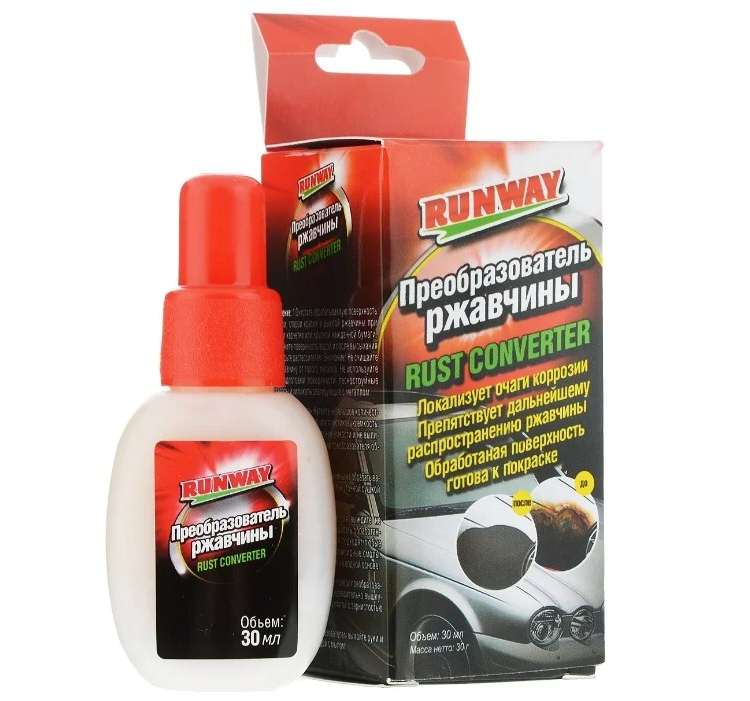
What can't be used and why?
For cleaning the blade and knife mechanism too aggressive drugs should not be used... If there are doubts about the product, it is recommended to apply one drop to the edge of the product before use in order to track the reaction and see the result.
This is especially true of antique knives that have carved steel handles. It is better to entrust the cleaning of such items to specialists.
How to protect the blade from corrosion?
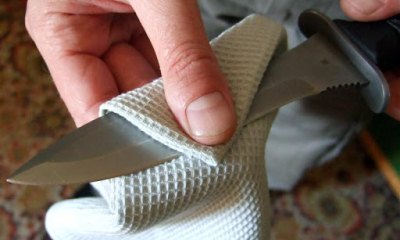 So that the problem of the appearance of a rusty coating on the knife blade does not bother, it is necessary to protect steel from adverse factors.
So that the problem of the appearance of a rusty coating on the knife blade does not bother, it is necessary to protect steel from adverse factors.
First of all, they include moisture. Rinse and dry the knives with a towel immediately after use.
Prevention requires compliance with storage rules... A sharp instrument is stored in oiled paper or special stands. This must be done for safety reasons and to keep moisture out of the blade.
If the knife is used for technical purposes, it can be wiped with kerosene. If it is not possible to use this substance, the blade is covered with a thin layer of wax.
It is recommended to use the knife as often as possible to prevent the onset of corrosion and to apply the cleaner in time. Even for sheathed decorative items, it is necessary to periodically revise.
Additional Tips
Any suitable method can be used to remove rusty marks from the knife. When choosing a product, you should focus on the degree of pollution, financial costs and the possibility of applying the method.
Anyway, it is advisable to take into account additional recommendations that will facilitate the cleaning process and help speed it up:
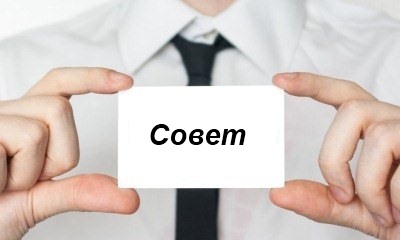 If the rusty coating is significant and after the first treatment has not completely disappeared, it is necessary to repeat the cleaning with the same product or choose another one.
If the rusty coating is significant and after the first treatment has not completely disappeared, it is necessary to repeat the cleaning with the same product or choose another one.- If the corrosion process has gone far and a continuous dense coating of rust has formed on the knife, then it is advisable to first remove it mechanically (sandpaper), and then complete the cleaning with any liquid agent.
- When using any chemical reagents, it is necessary to wear rubber gloves to protect the skin.
- After the complete removal of rusty marks, the blade is thoroughly washed with water and dried well. The presence of moisture can re-initiate corrosion.
Related videos
How to clean a knife from rust, the video will tell you:
Conclusion
To protect kitchen, hunting and other knives from corrosion, it is necessary to apply anti-rust agents in time. Both folk cleaners and special converters are suitable for purification. With the further use of the blade, you should remember about preventive measures and follow them regularly.

